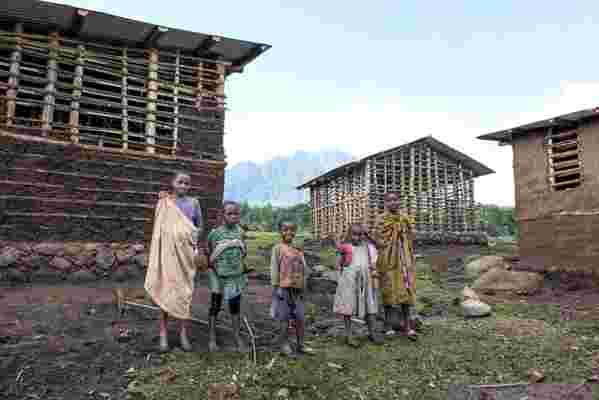In 1991, national parks were established across Rwanda, Uganda, and the Democratic Republic of the Congo to protect the severely endangered mountain gorillas that roamed the Virunga Mountains (from a low of 284 in 1981, the number of apes grew to 880 as of 2018). Today, lodges on the outskirts of the parks draw thousands of tourists each year, each of whom pays a hefty fee to trek into the mountains to spend an hour with the wild gorillas. It’s become a major industry for these East African countries, creating jobs, fueling the economy, and most important, protecting the gorillas. But what’s often overlooked in this inspiring conservation story is an element of displacement: In creating the national parks, the Batwa—one of the oldest indigenous tribes in Africa—were ousted from their forest homes, and they’ve been living as squatters on the farmland in Uganda ever since. But a group of 18 Batwa families has been given a second chance, thanks to the luxury lodge operator Volcanoes Safaris , which has teamed up with architect Felix Holland to build a permanent village for them.
Volcanoes Safaris founder and owner Praveen Moman, who was born in Uganda, has operated a nonprofit through his company for a decade. “Generally, we want to support people and improve their livelihoods in relation to the work we do at our lodges,” Moman says. Since opening his Mount Gahinga Lodge just outside Mgahinga Gorilla National Park in Uganda in 1997, Moman became quite familiar with the Batwa, particularly a group of whom had built a makeshift village nearby. “It was a bunch of rocks on which they built little shacks of twigs, of tarpaulins, of cardboard—whatever they could get,” he says. Architect Felix Holland adds, “It was the most appalling piece of human habitation I’ve ever seen.”

Batwa children stand in front of their new homes, still under construction.
Moman eventually established a relationship with the Batwa tribe, building a vocational center to teach them marketable skills and opening the Batwa Heritage Trail on the property to educate the lodge’s guests about the ancient culture. He also took his guests to the dismal village in hopes of informing them about the plight of the Batwa. “And then I thought one day, ‘This seems ridiculous,’” says Moman. “Why are we just sharing people’s misery? What are we going to do about this? They can’t just stay here forever.”
He then went on to purchase ten acres of farmland near Mount Gahinga Lodge to give the Batwa group their own space for a village. But as the tribe had spent centuries in the forest, they needed to learn an entirely new set of skills to adapt to their new home. Not only did they have to be taught how to farm—the Batwa were hunter-gatherers in the forest—but they also had to learn new building skills to construct their homes. In the forest, the Batwa’s traditional houses were made from branches loosely woven together. This works for forested terrain, given the extra protection of the foliage, but it’s impractical for open expanses of farmland, where wind and rain would sweep through the gaps.
Moman reached out to Holland, whose Uganda-based firm Studio FH Architects works with Volcanoes on its four lodges across East Africa, to consult on the project. To find out what the Batwa wanted, the architect asked them to design a model home—which turned out to be a tiny, three-room structure made of branches, just as they were used to. “That model house is what we used as a floor plan, but we doubled the size,” says Holland. “The rooms that they had proposed were as small as three by nine feet, so we felt like we could probably afford to make them little bigger.”

The community center at the Gahinga Batwa Village.
As for the materials, Holland knew they couldn’t use branches, given the climate, but he also wanted to avoid using outside materials like brick. “When organizations bring in brick for a project like this, once the brick degrades, the inhabitants can’t fix it,” he says. “They’re waiting for someone else to come in and fix it.” He instead opted for a local construction method called wattle and daub, in which bamboo and eucalyptus are used to create a frame for the structure, which is then covered with earth plaster. “The good thing is, when it eventually breaks down, the Batwa can maintain that,” Holland notes. “It’s low-cost.”
The village officially opened in May 2018 with 18 houses, a community center designed by Holland that will be used for education, and acres of farmland. “The more we have worked with the Batwa, the more proactive and the more involved they’ve been. They built those houses,” Moman said at the opening. “Yes, we have provided the land, we have provided the materials, but they’ve been up there since six o’clock every morning, building their homes.” Today, guests at Volcanoes Safaris’ Mount Gahinga Lodge can visit the village and see performances by the Batwa in the community center. It’s a clever way to turn over a new leaf for the Batwa—one that works in favor of the tribe, the gorillas, and the visitors who want to meet both.

Leave a Reply